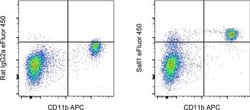Learn More
Invitrogen™ Sall1 Monoclonal Antibody (NRNSTNX), eFluor™ 450, eBioscience™, Invitrogen™
Rat Monoclonal Antibody
Supplier: Invitrogen™ 48972982

Description
Description: This NRNSTNX monoclonal antibody recognizes mouse Sall1. Applications Reported: This NRNSTNX antibody has been reported for use in intracellular staining followed by flow cytometric analysis. Applications Tested: This NRNSTNX antibody has been tested by intracellular staining followed by flow cytometric analysis of mouse brain cells using the Intracellular Fixation & Permeabilization Buffer Set (Product # 88-8824-00) and protocol. Please refer to Staining Intracellular Antigens for Flow Cytometry, Protocol A: Two step protocol for intracellular (cytoplasmic) proteins located at www.thermofisher.com/flowprotocols. This may be used at less than or equal to 1.0 μg per test. A test is defined as the amount (μg) of antibody that will stain a cell sample in a final volume of 100 μL. Cell number should be determined empirically but can range from 10^5 to 10^8 cells/test. It is recommended that the antibody be carefully titrated for optimal performance in the assay of interest. eFluor 450 is an alternative to Pacific Blue. eFluor 450 emits at 446 nm and is excited with the violet laser line (405 nm). Please make sure that your instrument is capable of detecting this fluorochrome. Excitation: 405 nm; Emission: 445 nm; Laser: Violet Laser
Sall1, which encodes a zinc finger protein, functions as a transcriptional repressor and interacts physically with histone deacetylase and other components of the chromatin remodeling NuRD complex. It is unknown whether the transcriptional repression is solely dependent on histone deacetylase activity. Gene expression profiling has identified Sall1 as a microglial signature gene. Microglia are the resident macrophages of the central nervous system (CNS). Sall1 is also expressed in abundance in the mesenchyme-derived structure from condensed mesenchyme, S-comma-shaped bodies, to renal tubules and podocytes. Sall1 has been identified as a key transcription factor in self-renewal renal progenitor cells. Sall1 is required to maintain the stemness of nephron progenitor cells by restraining their differentiation into renal vesicles. Defects in SALL1 are the cause of Townes-Brocks syndrome as well as bronchio-oto-renal syndrome. Heterozygous mutations of human SALL1 leading to Townes-Brocks syndrome features dysplastic ears, preaxial polydactyly, imperforate anus, and less commonly, kidney and heart anomalies (Kohlhase et al. 1998). Two transcript variants encoding different isoforms have been found for this gene.
Specifications
| Sall1 | |
| Monoclonal | |
| 0.2 mg/mL | |
| PBS with 0.09% sodium azide; pH 7.2 | |
| Q9ER74 | |
| SALL1 | |
| C-terminal fragment of the protein (aa-805-1322). | |
| 100 μg | |
| Primary | |
| Mouse | |
| Antibody | |
| IgG2a κ |
| Flow Cytometry | |
| NRNSTNX | |
| eFluor 450 | |
| SALL1 | |
| epididymis secretory protein Li 89; HEL-S-89; HSal1; Msal-3; SAL1; Sal-1; sal-3; SALL1; sal-like 1; sal-like 1 (Drosophila); sal-like protein 1; spalt like transcription factor 1; spalt-like transcription factor 1; TBS; Zinc finger protein 794; zinc finger protein SALL1; Zinc finger protein Spalt-1; zinc finger protein Spalt-3; ZNF794 | |
| Rat | |
| Affinity Chromatography | |
| RUO | |
| 58198 | |
| 4°C, store in dark, DO NOT FREEZE! | |
| Liquid |
The Fisher Scientific Encompass Program offers items which are not part of our distribution portfolio. These products typically do not have pictures or detailed descriptions. However, we are committed to improving your shopping experience. Please use the form below to provide feedback related to the content on this product.
